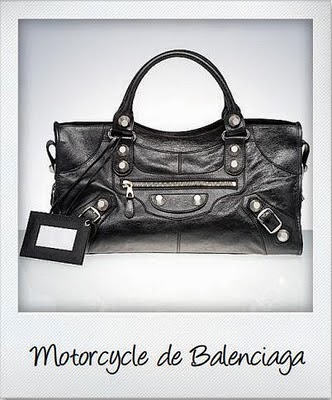¡Buenos días chicas!
¿Cómo va la semana? ¡Animo que ya
es viernes!
Vamos con otro modelo que se ve
mucho desde hace años. El Motorcycle de Balenciaga.
Aquí os dejo la historia de la casa Balenciaga. Una
marca con mucha más historia que las que hemos comentado
últimamente.
Cristóbal Balenciaga opened his first boutique in
San Sebastián, Spain, in 1914, which expanded to include branches in Madrid and
Barcelona. The Spanish royal family and the aristocracy wore his designs, but
when the Spanish Civil War forced him to close his stores, Balenciaga moved to
Paris.
Balenciaga
opened his Paris couture house on Avenue George V in August 1937, and his first
runway show featured designs heavily influenced by the Spanish Renaissance.
Balenciaga's success in Paris was nearly immediate. Within two years, the French
press lauded him as a revolutionary, and his designs were highly sought-after.
Carmel Snow, the editor of Harper's Bazaar was an early champion of his
designs.
Customers risked their safety to travel to Europe
during World War II to see Balenciaga's clothing. During this period, he was
noted for his "square coat," with sleeves cut in a single piece with the yoke,
and for his designs with black (or black and brown) lace over bright pink
fabric.
However, it was not until the post-war years that
the full scale of the inventiveness of this highly original designer became
evident. His lines became more linear and sleek, diverging from the hourglass
shape popularized by Christian Dior's New Look. The fluidity of his silhouettes
enabled him to manipulate the relationship between his clothing and women's
bodies. In 1951, he totally transformed the silhouette, broadening the shoulders
and removing the waist. In 1955, he designed the tunic dress, which later
developed into the chemise dress of 1958. Other contributions in the postwar era
included the spherical balloon jacket (1953), the high-waisted baby doll dress
(1957), the cocoon coat (1957), the balloon skirt (1957), and the sack dress
(1957). In 1959, his work culminated in the Empire line, with high-waisted
dresses and coats cut like kimonos. His manipulation of the waist, in
particular, contributed to "what is considered to be his most important
contribution to the world of fashion: a new silhouette for
women."
In the 1960s, Balenciaga was an innovator in his use of fabrics: he tended toward heavy fabrics, intricate embroidery, and bold materials. His trademarks included "collars that stood away from the collarbone to give a swanlike appearance" and shortened "bracelet" sleeves. His often spare, sculptural creations—including funnel-shape gowns of stiff duchess satin worn to acclaim by clients such as Pauline de Rothschild, Bunny Mellon, Marella Agnelli, Gloria Guinness and Mona von Bismarck—were considered masterworks of haute couture in the 1950s and 1960s. Jackie Kennedy famously upset John F. Kennedy for buying Balenciaga's expensive creations while he was President because he feared that the American public might think the purchases too lavish. Her haute couture bills were eventually discreetly paid by her father-in-law, Joseph Kennedy.Cristóbal Balenciaga left the house in 1968.
In the 1960s, Balenciaga was an innovator in his use of fabrics: he tended toward heavy fabrics, intricate embroidery, and bold materials. His trademarks included "collars that stood away from the collarbone to give a swanlike appearance" and shortened "bracelet" sleeves. His often spare, sculptural creations—including funnel-shape gowns of stiff duchess satin worn to acclaim by clients such as Pauline de Rothschild, Bunny Mellon, Marella Agnelli, Gloria Guinness and Mona von Bismarck—were considered masterworks of haute couture in the 1950s and 1960s. Jackie Kennedy famously upset John F. Kennedy for buying Balenciaga's expensive creations while he was President because he feared that the American public might think the purchases too lavish. Her haute couture bills were eventually discreetly paid by her father-in-law, Joseph Kennedy.Cristóbal Balenciaga left the house in 1968.
Mis favoritos:







No hay comentarios:
Publicar un comentario